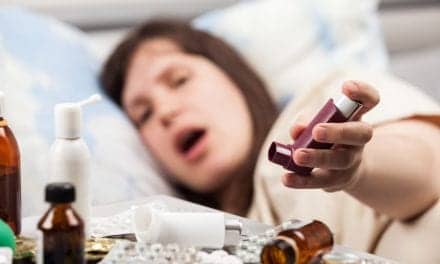Between 20% to 30% of children living in close proximity to Comer Children’s Hospital on the South Side of Chicago have asthma, which is 2-3-times the Illinois state average of 10%, according to UChicago Medicine.
“Exposure to allergens – such as cockroaches, mouse droppings, and mold in low-income housing, and urban outdoor pollution – can exacerbate asthma and increase the incidence in children,” said Sharmilee Nyenhuis, MD, Associate Professor of Pediatrics and Medicine, Section of Allergy and Immunology. “Low birth weight can also contribute to poor development of the lungs, which increases the risk of asthma.”
Although the treatment of asthma has focused on pharmacologic therapy, Nyenhuis believes there may be a better option for preventing the progression of the disease—regular physical activity. “Good data shows that exercise can improve asthma control and lung function and reduce exacerbations of asthma, sometimes equivalent to some medications,” said Nyenhuis.
In an ongoing trial, Nyenhuis is investigating whether exercise may improve asthma in Black women, who have the lowest rates of regular physical activity. Less than 15% get the recommended amount of physical activity. They also have higher rates of asthma exacerbations and healthcare use, worse lung function, poorer asthma-related quality of life, and a higher crude asthma mortality rate compared with White women.
Previous studies of physical activity to help control asthma have overlooked Black women, which Nyenhuis aims to rectify with the current trial. She hopes to expand her study to include Black girls with asthma and their mothers. Nyenhuis has applied for funding to conduct a companion randomized trial of an exercise intervention in Black mothers and their 8- to 12-year-old daughters with asthma.
“Mothers of school-age girls can have a positive influence on their daughters’ level of physical activity,” said Nyenhuis, who also serves as Associate Chair for Diversity, Equity and Inclusion for the Department of Pediatrics. “We are including mothers in this new study so that they can model exercise habits and provide support to their daughters.”
Black girls have higher rates of uncontrolled asthma, asthma mortality, asthma-related ED visits and hospitalizations than White girls. Black boys also have a higher incidence of asthma than other population groups but tend to be more physically active than Black girls and, therefore, less likely to benefit from exercise interventions, according to Nyenhuis.
“If we can help girls develop a lifelong habit of exercising, they may have better asthma control as adults and realize the other benefits of exercise, such as a reduction in obesity and in metabolic diseases like diabetes and cardiovascular disease,” said Nyenhuis.
She plans to conduct focus groups to explore the types of exercise that will appeal to both the girls and their mothers. “Our main goal is to improve asthma outcomes and reduce health disparities for Black girls and their mothers,” she said.
Promising Asthma Outcomes in Black Women
The randomized trial in progress, which centers around a walking intervention, is being conducted by Nyenhuis along with colleagues from the University of Illinois at Chicago. The study, funded by the National Institute on Minority Health and Health Disparities, will randomly assign 224 women to an intervention called Physical Activity in Minority Women with Asthma (ACTION), or to an asthma education-only group.
During the 24-week study, members of the intervention group receive an asthma education session led by a Black instructor. Each woman has a Fitbit to measure her steps, goes on monthly group walks, and receives custom text messages to provide support and step objectives.
“We are using behavioral techniques to help participants increase their number of steps and the intensity of exercise,” Nyenhuis said. The control group receives an asthma education session, asthma advice and additional asthma education via text messages.
Results from a pilot study of 53 women randomized to the ACTION intervention or to enhanced usual care showed that the women receiving the intervention had controlled asthma and clinically significant improvements in quality of life compared with the control group at 24 weeks.
Besides evaluating changes in lung function and asthma control in the study participants, Nyenhuis and her colleagues are studying how the women overcome environmental and societal barriers that threatened to prevent them from achieving their walking goals.
“There are significant challenges for women and girls living on the South Side of Chicago to exercise, such as poor outdoor air quality due to heavy industry and construction, and violence or other dangers on neighborhood streets,” said Nyenhuis. The study directly addresses these adverse social determinants of health.
To mitigate the effects of air pollution, for example, the researchers send the participants alerts on days when the air quality is particularly poor or outdoor temperatures are too hot or cold for safe walks. On those days, the women receive guidance on where they can achieve their step goals indoors, such as walking hallways or climbing stairs.
Some participants have expressed their fears of walking in their neighborhoods because of gang violence and other threats. During group sessions, the participants discuss ways they can feel safer, such as walking during specific times of the day, avoiding certain areas, or walking with a partner. “We are relying on the collective IQ of this community of women to develop strategies that enable them to continue exercising despite the challenges,” said Nyenhuis.
Overcoming adverse social determinants of health in asthma management is a major theme of Nyenhuis’ research. “Although complicated in clinical practice, it’s critical that we address unmet social needs in our patients with asthma,” she said. “We need to screen children for risks, such as food and housing insecurity, exposure to violence and stress, which can greatly influence the development and progression of asthma.” Caregivers of children who visit Comer’s outpatient clinics, for example, receive a questionnaire asking about gaps in patients’ social needs. If food insecurity is identified, the family is referred to resources such as Comer’s food pantry.
Young patients with asthma treated at Comer Children’s may see allergy and pulmonary pediatric subspecialists as well as Child Life specialists and social workers. Clinicians may also refer patients to the South Side Pediatric Asthma Center (SSPAC), a multi-institution initiative led by Comer Children’s and other healthcare agencies. Community health workers trained in asthma work with families of high-risk children and enhance access to physicians.
“Community health workers will do home visits to identify what environmental factors may be causing uncontrolled asthma symptoms and they provide resources to reduce exposures to allergens, such as cockroaches and mold,” said Nyenhuis, the clinical director of the SSPAC. “They also provide asthma education and connect patients to community resources related to asthma management.”
Families referred to the SSPAC report a 73% decrease in missed school days and 52% fewer ED visits. “We know that clinical-community partnerships and resource referrals can mitigate existing inequities in low-income and minoritized children with asthma,” said Nyenhuis. “We want to do everything we can to give them a fighting chance to control their asthma and to live free of symptoms.”










